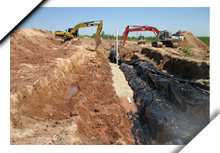SKA was retained to investigate the source of saltwater seeps affecting shallow groundwater on an oil and gas producing property and to develop a means to prevent the seepage. Shallow groundwater had chloride concentrations of up to 30,000 mg/L and total dissolved solids concentrations of up to 50,000 mg/L. Seeps were impacting vegetation and contributing to surface water quality degradation downstream. SKA initially drilled 29 piezometers topographically upgradient from the seep areas to assess the depth to groundwater and determine the depth to the contact with the lower aquitard. SKA then designed the trench to intercept the shallow groundwater and be keyed up to two feet into the underlying aquitard while maintaining an excavation depth of not more than 15 feet. Consequently the 1,400-foot long trench was composed of several segments at different slopes and bearings rather than one straight trench at a constant slope. The trench was excavated with a hydraulic excavator and a 6-inch slotted PVC well screen was installed in the trench as a collection pipe. There were 3 vertical sumps installed to recover the collected groundwater along with 4 clean-out locations for removing any form a hydraulic barrier to groundwater migration. The trench was backfilled with 5 feet of minus 3/8-inch pea gravel over the collection pipe. A geotextile fabric was laid down over the pea gravel and the remainder of the excavation was backfilled with native material. The sumps were completed with surface-mounted jet pumps that pumped the chloride-contaminated groundwater to a client-supplied tank battery for off-site disposal.

